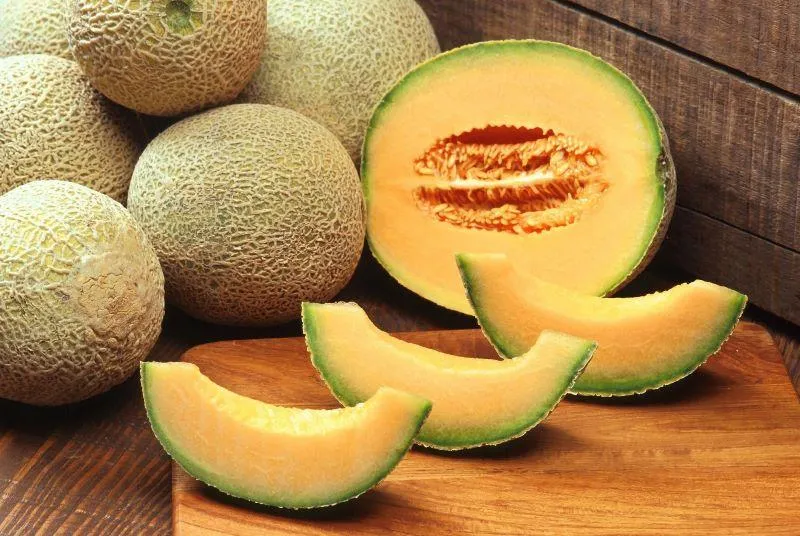
Your Backyard Fruit Bowl — Melons
Life is a thump-ripe melon, so sweet and such a mess.
- Greg Brown, American folk musician.
Melons: a short family history
Suitable climates and growing conditions
Site selection, culture and care
Pests, diseases and what to do about them
What is a hot summer’s day without a dripping slice of slightly-chilled melon? Lacking something, I reckon. Whether it’s crimson-fleshed watermelon, aromatic orange rockmelon with its rough, brown-netted skin or delicate, velvet-smooth green honeydew melon that floats your boat, being able to cultivate these curvaceous cucurbits is the height of summer gardening success.
I’ve long wanted to be in the right situation to be able to have a decent melon patch, but alas, I’ve either been in the wrong climate with the right growing space at my fingertips, or living in a suitable climate with not enough space to grow these sprawling giant vines. I remember an attempt at rockmelon production in our tiny glasshouse in Marlborough, long before gardening became my responsibility, and I did manage to produce one fist-sized rockmelon with the help of a cold frame in Canterbury one hot summer. But I can’t say my current coastal climate is conducive of melon production, despite a couple of attempts with the diminutive Sugar Baby cultivar in the greenhouse. My latest batch of seedlings was dispatched by slugs, with just a sole survivor. I’ll nurture it best I can, but am not holding out high hopes in this strangest of summers.
There’s great diversity amongst the melon clan, and their sweet, juicy inner nature makes them a hit with small fry – I’m yet to see a young’un turn down watermelon in any way, shape or form. If you live in a warm climate and have a few square metres of spare cultivation space, then growing some melons from seed could be a great summer school holiday project.
The main requirements are adequate space, a sheltered site, good summer warmth, adequate water and access to some decent compost or rotted manure to provide the necessary oomph for the plants early on. Get everything just right, and you can expect a colossal crop of fruit to see you through summer.
Melons: a short family history
Melons belong to the Cucurbitaceae, a diverse plant family with its roots in Asia and Africa. Their close relatives include cucumbers, pumpkins and the summer and winter squashes. There’s evidence cucurbits have been utilised by humans as far back as 12,000 BC, with melons themselves likely being used as a food source for humans since at least 2800 BC. Melons exhibit extraordinary diversity, with different species adapted to tropical, desert and arid climates. Botanically, the fruit is known as pepo, essentially a berry with a hard rind.
Two genera produce the melons we are most familiar with on the supermarket shelf: Cucumis spp. melons include rock, musk, honeydew and canary melons, while the genus Citrullus gives us the ever-popular watermelons. There are also oddities such as the Kalahari Desert-native citron, pie or stock melon, Citrullus amarus, prized by some for preserving and jam-making – unfortunately this species has naturalised and become a pest plant in some areas of Mexico and Western Australia; and Cucumis metuliferus, the African horned melon, more commonly known as the kiwano in these parts. This spiky oddball that turns up in greengrocers every now and again and no one ever knows quite what to do with it – heaven help you if you receive one as a gift.
While melons are prized primarily as a sweet dessert fruit in Western culture, across Africa and Asia the seeds are considered just as valuable as a food source. They are used much like nuts and consumed raw or roasted, or even ground into flour. Oil pressed from the seeds is used for cooking and dressings. China is the biggest producer of watermelons on a global scale, producing roughly two-thirds of the world’s annual crop. The fruit you’ll find on New Zealand shelves is usually locally grown, or out of season, shipped in from Australia or the Pacific Islands.
Suitable climates and growing conditions
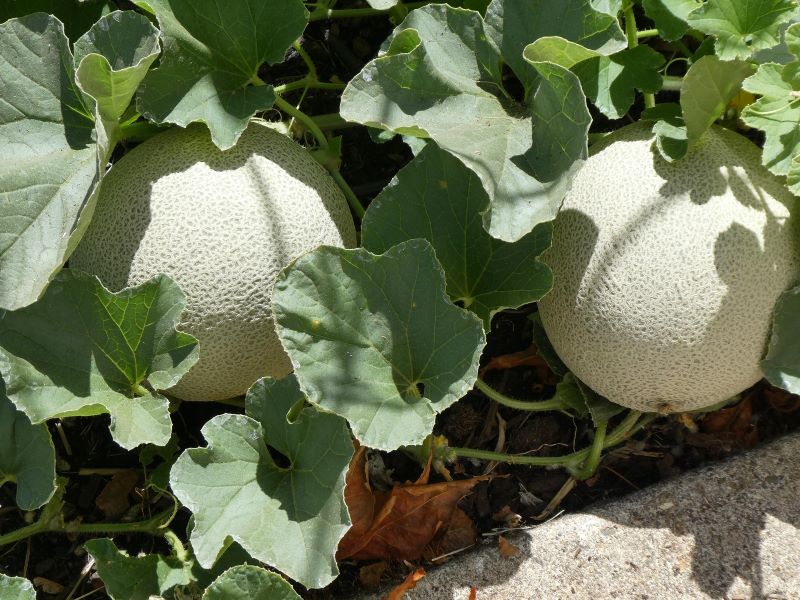
Rockmelon on vine: Image by Davgood Kirshota via pixabay.com
Frost-tender melons are generally considered a warm-climate crop, but can be grown successfully in temperate zones given an early start under glass and protection during the growing season. They require fairly long, hot summers for proper ripening. Crops grown south of Nelson-Marlborough will likely need extra care and attention, but are not impossible to achieve.
Melons are annuals, with new plants needing to be propagated from seed each year and are best started indoors or in a greenhouse or glasshouse. Sow seeds in late spring into pots containing a good-quality seed raising mix – recycled six-cell vegetable punnets are ideal for this. They should germinate within a week to ten days.
Pot on once into larger, single-plant pots once the first true leaves are well developed, handling the seedlings with care as cucurbits don’t like their roots being disturbed. Move the plants to a greenhouse once it’s warm enough, and grow on until the plants have four or five well-developed true leaves. You can transplant these out in their growing position once the soil has warmed sufficiently and the danger of frosts has passed. In northern regions, seeds can be direct sown outside around November time.
When transplanting, allow a metre between plants and also a metre between rows, so, much like zucchini plants, a square metre of space is required per plant. The melon growth habit is somewhat sprawling, like their pumpkin cousins, and is summed up well by the verse of French poet Marc-Antoine Girard de Saint Amant: ‘O sweet grassy snake, crawling on a green bed’. The creeping-climbing Cucumis species can be trained up structured frameworks if necessary. This isn’t advisable with Citrullus species as the size of their fruit means they are best left to run along the ground.
Male and female flowers are borne on the same plants, and sometimes separate plants, so it is best to plant several melon seedlings to ensure a good crop. Pollination is by insects, and you can also assist by hand pollinating with a paintbrush if you think the bees aren’t playing their part. As with most cucurbits, male flowers appear first and you can easily distinguish these from the females, which have the tiny bulge of an immature melon behind their petals.
Most melons will begin to mature fruit 75-85 days from transplant in regions with consistent summer daytime temperatures of around 25°C. Expect 6-10 fruit per plant; although for optimum fruit quality it’s wise to thin to 4-6 fruits per plant. The fruit must be fully ripened on the vine; melons do not continue to ripen off the plant. Test watermelons for ripeness by knocking on the fruit with your knuckles, a dull sound means the fruit is ripe. An alternative method involves pressing the fruit between your hands, if a cracking sound is heard, the fruit is ripe. For rockmelons, the stem end will begin to dry out and can be easily snapped off when the fruit is ripe, there may also be a slight softening at the stem end; you may also note a strong, sweet aroma coming from the fruit. For all melons, the ultimate test for ripeness is to cut one open and sample the flesh.
Store the fruit in a cool, dry place in the medium term, however, they will not last forever and are susceptible to the ingress of fungal rots over time. Wrap cut sections tightly in cling film before refrigerating as the smell tends to permeate other stored foods.
Site selection, culture and care
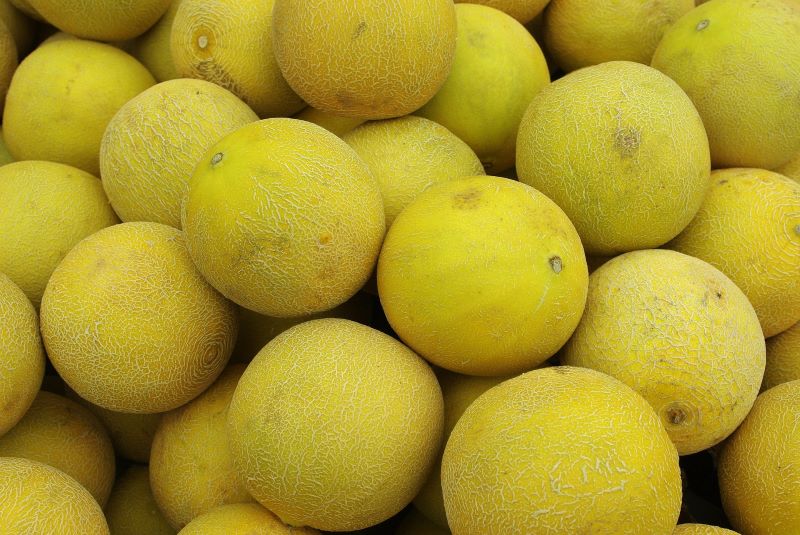
Honeydew melons: Image by Ralph Kleina pixabay.com
Choose a hot, dry, sunny, sheltered site for your melon patch. Melons thrive in well-drained sandier soils of fairly neutral pH 6-7. A generous application of compost or rotted manure at planting is appreciated. You can use foliar feeds (e.g., liquid seaweed or fish preparations) during fruit formation, but ease these back once the fruit starts to ripen. Application of excess nitrogen during ripening can negatively affect how well your melons will store long-term.
Once your Cucumis melon plants establish and have about a good metre or so of growth, you can pinch out the growing tip to encourage lateral stems to develop. Once these laterals have developed about five leaves, the growing tips of these can then be pinched out and the plant will develop secondary laterals, which will bear flowers.
Citrullus (water) melons don’t need to be trained like this, they are just left to sprawl. Because they require a few more heat units to ripen their fruit, you could try laying down sheets of black plastic at planting and feeding the seedlings through holes in this to help keep the roots consistently warm.
Melon plants like plenty of water and happily tolerate humidity in the establishment phase and fruit formation, so keep up with the irrigation but don’t allow the ground to become waterlogged.
Planning an orchard? Here’s our guide to getting started with backyard fruit growing in New Zealand.
Pests, diseases and what to do about them
Melons are susceptible to powdery mildew fungus - ensuring plants are adequately spaced at planting, maintaining plant nutrition and avoiding overwatering and are your best measures for preventing this. You may notice odd geometric patterns appearing on the leaves of some plants; this is a general indicator of plant viruses, of which the vectors are commonly insects. Again, not a lot can be done, you can remove badly infected plants and keeping the weeds in and around your melon patch at bay can help by reducing the habitat available for insect pests. When weeding and cultivating, don’t dig deeply around your melon plants as they have very shallow root systems and as mentioned previously, don’t like these being disturbed.
Varieties: My top picks
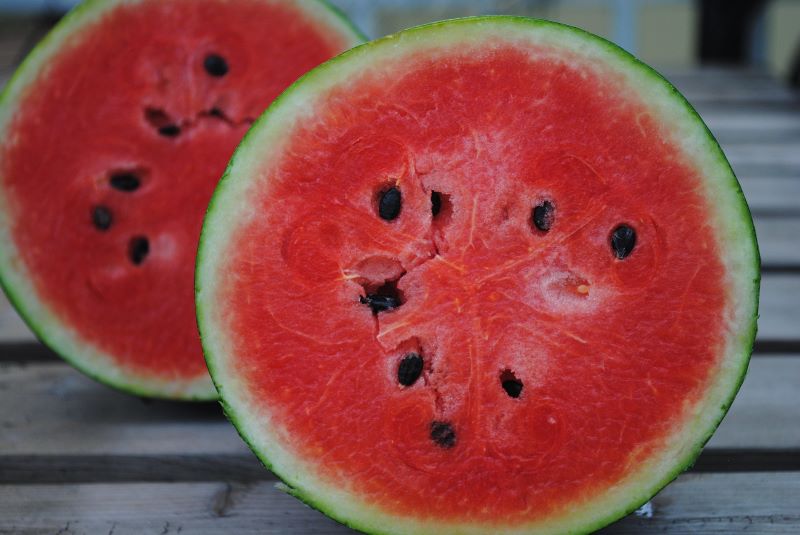
Watermelons: Image by NGUYỄN THỊ THY via pixabay.com
Watermelons (Citrullus spp.)
Gold in Gold (hybrid) – Has gold-striped yellow skin with orange-gold flesh which is very sweet and crisp. Vigorous, disease-resistant plants producing large, oval fruits with a strong rind. Fruit matures 70 days from transplant.
Moon & Stars – Round to elongated, dark green-skinned fruit scattered with small yellow dots and larger round yellow ‘moons’. The yellow speckling is also present on the leaves (this is not a disease!). Large red-fleshed fruit with excellent flavour. Fruit matures 85 days from transplant.
Sugar Baby – Smaller, round, dark green-skinned melon with pink flesh. Strong, crack-resistant rind. Fruit matures 85 days from transplant.
Peace (hybrid) – Early-maturing yellow-fleshed melon with crisp textured, sweet flesh. Fruit matures 110 days from sowing.
Charleston Grey – Elongated, light grey-green skinned fruit with red flesh which is fine textured, sweet and not too seedy. Fruit matures 130 days from sowing.
Rockmelons and honeydew types (Cucumis spp.)
Western Express (hybrid rockmelon) – A good choice for New Zealand gardens, adapted for our cooler temperate climate and early maturing. Large, round-oval fruit with deep orange flesh and a small seed cavity. Fruit matures 110 days from sowing.
Hales Best Jumbo (rockmelon) – A popular older variety of rockmelon, needs a long ripening season but is powdery mildew resistant. Large fruit (~1 kg) which has sweet, juicy orange flesh. Fruit matures 125 days from sowing.
Jenny Lind (rockmelon) – Small to medium round ‘turban’ shaped rockmelon with a distinctive knob at the blossom end. Very sweet and juicy green-fleshed rockmelon that is easy to grow. Fruit matures 80-90 days form transplant.
Honeydew – Pale green-skinned melon with chartreuse-green flesh. Extremely sweet and juicy; best served chilled. Fruit matures 110 days from sowing.
Seeds of the Ukrainian cultivar Collective Farm Woman, a golden yellow-green skinned, white fleshed melon used to be available from suppliers in New Zealand but seems to have disappeared from general circulation. If you can get hold of seeds, give it a go. The flesh is crunchy and sweet and the fruit keeps well.
What to do with your crop
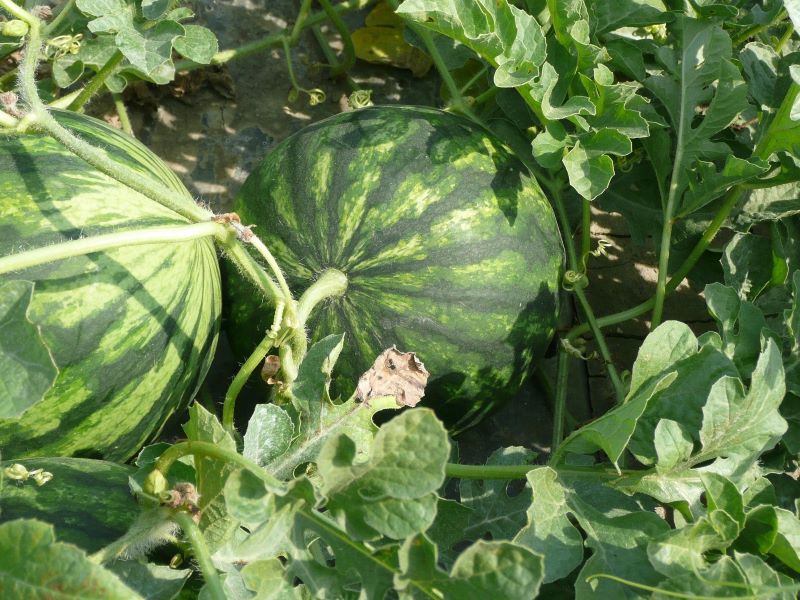
Watermelon on vine: Image by a lorenzoandreotti via pixabay.com
First and foremost, enjoy your melons as fresh dessert fruit while wondering at the marvel of this particularly appropriate watermelon haiku by Mexican poet José Juan Tablada:
Summer’s loud laugh
Of scarlet ice
A melon
slice
Melons of all kinds lend themselves beautifully to summery salads where sweet and savoury collide; from the continental paring of rock and honeydew melons with prosciutto to the more contemporary watermelon, feta and black olive salad popularised by Nigella Lawson.
They also have a well-deserved place in all manner of chilled summer desserts, the best of which are many and varied gelatos and sorbets. All three common colours of melon (red, green and orange) can be employed to dramatic effect in traffic light fashion, if you have the time and inclination to make separate varieties of these iced desserts.
Melons, especially the rock and honeydew types have a special affinity with ginger in all its forms and I once made a pretty good rockmelon gelato enhanced with a hit of chilli flakes. Watermelon’s extremely high water content lends it particularly well to juicing, and the juice can even be made into wine, on its own or in combination with other fruits.
Watermelon rind pickle is commonplace throughout the southern United States, and in Spain and France, the rind is candied and included in glace fruit selections used for baking. Kalingar nu Shaak is a traditional Gujarati curry which utilises watermelon rind as the main ingredient – yet another brilliant way to fight food waste!
Jane Grigson’s excellent Fruit Book (Michael Joseph, 1982) details a delicate Russian soup consisting of pureed melon, a sugar syrup, dry white wine and sour cream, sharpened with lemon juice. It’s recommended for serving as a first course at a summer dinner party, or as a dessert with tiny meringues or almond biscuits.
If you’re not feeling adventurous enough to try melon soup, here’s a basic sorbet recipe that you can use any kind of melon for – perfect for hot summer days.
Any-melon sorbet
1 cup sugar
2/3 cup water
4 cups peeled, seeded, and cubed ripe melon (equivalent of a medium rock or honeydew melon)
Combine the sugar and water in a saucepan. Bring to the boil and stir until the sugar dissolves. Remove from the heat and cool. Cover and chill the syrup for at least an hour in the fridge.
Puree the melon in a blender or food processor until smooth (you may need to do this in batches).
Mix the melon puree with the sugar syrup. Pour the mixture into a large freezer-safe flat metal pan. Freeze for 3-4 hours.
Remove from the freezer and scrape the mixture into a large bowl. Beat the sorbet until light and fluffy, by hand or with an electric beater.
Pack into a plastic ice cream container or similar for storage and seal the container. Freeze for at least three hours before serving.
Experiment with adding additional flavours – e.g., ginger, citrus rind or juice, or a pinch of chilli to taste.
Disclaimerthe information supplied above is of a general nature and provided as reference material only. In regards to pest and disease control, please consult your agrichemical consultant for suitable products, application rates and further region-specific information.
Anna-Marie Barnes is an active member of the New Zealand Tree Crops Association who endeavours to grow and preserve as much of her own fresh produce as possible. When the weather’s no good for gardening, she can usually be found inside working on a batch of homemade cheese or soap.
The New Zealand Tree Crops Association is a voluntary organisation promoting interest in useful trees, such as those producing fruit, nuts, timber, fuel, wood, stock fodder, bee forage and other productive crops. Find out more about the NZTCA here: https://treecrops.org.nz/
Image Credits:
Honeydew melons: Image by Ralph Kleina pixabay.com
Watermelons: Image by NGUYỄN THỊ THY via pixabay.com
Rockmelon on vine: Image by Davgood Kirshota via pixabay.com
Rockmelon: Image by publicdomainimages via pixabay.com
Watermelon on vine: Image by a lorenzoandreotti via pixabay.com

